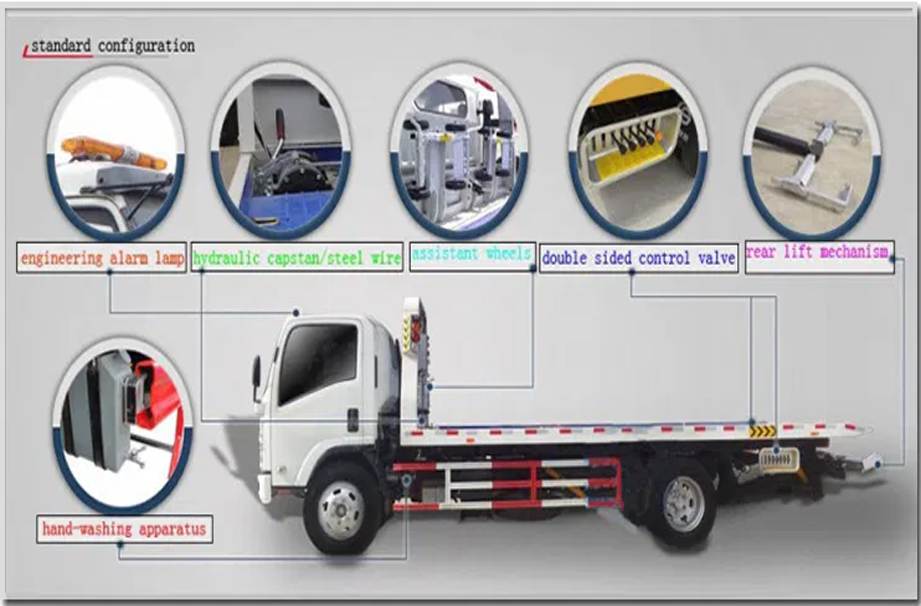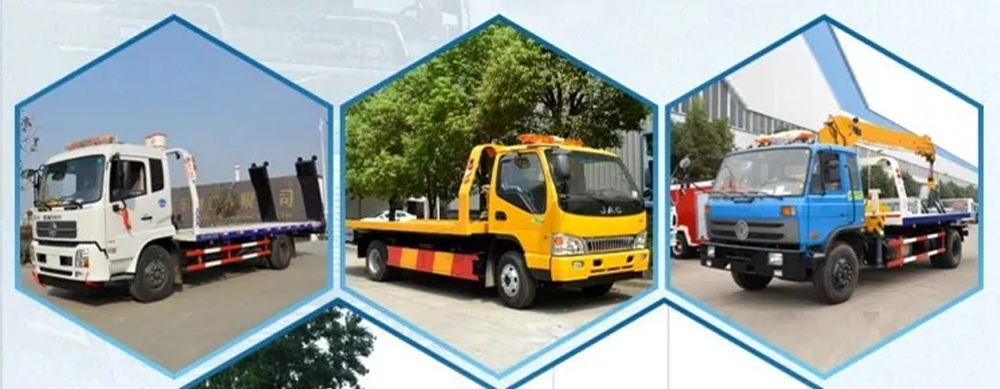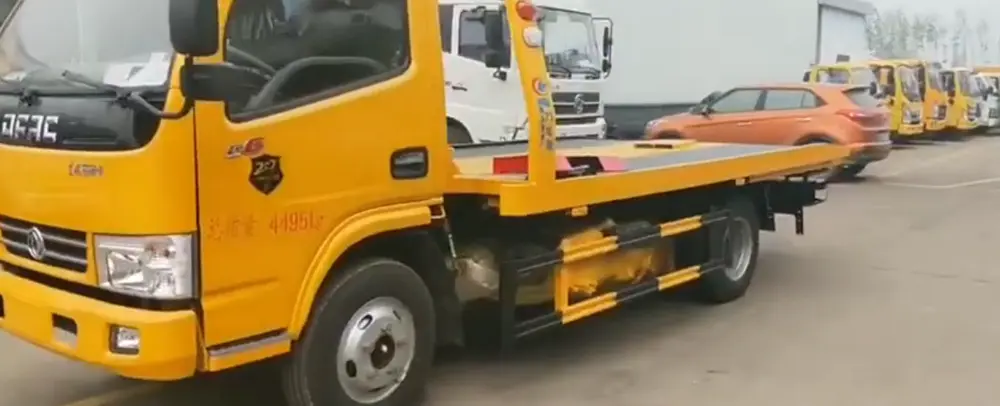The hallmark feature is the flatbed, typically crafted from high-strength steel, providing a sturdy and level surface. It offers ample space to accommodate various vehicles, from compact cars to medium-sized trucks. The flatbed is often equipped with a winch system, allowing operators to smoothly pull disabled vehicles onto it.
Powered by robust engines, these trucks have excellent towing capacity and can navigate different terrains reliably. The chassis is built to withstand heavy loads, paired with a durable suspension system that cushions vibrations during transportation.
The operator's cabin is designed for comfort, with ergonomic seating and intuitive controls. Additionally, modern Flatbed Wrecker Trucks come equipped with safety features like flashing lights and warning signs, ensuring the towing process is carried out safely, day or night, making them a go-to choice for roadside assistance and vehicle recovery services.
| The specification of Dongfeng 4 Tons Flatbed Wrecker Truck | ||
| Description | Dongfeng One Carry Two Recovery Truck | |
| Drive Model | 4x2 | |
| Vehicle Main Dimensions | Dimensions(L x W x H)mm | 7420X2300X2540 |
| Wheel base (mm) | 3800 | |
| Overhang (front/rear) (mm) | 1180/2440 | |
| Wheel track (front/rear) (mm) | 1835/1640 | |
| Approach/Departure angle(°) | 20/10 | |
| Weight in KGS | Curb Weight | 5495 |
| GVW. | 7490 | |
| Max. driving speed(km/h) | 90 | |
| Engine | Model | CY4102 |
| Type | 4-stroke direct injection, 4-cylinder in-line with water cooling, turbo-charging and inter-cooling | |
| Horse Power(HP) | 120HP | |
| Emission standard | Euro II | |
| Gearbox | 5 forwards & 1 reverse | |
| Clutch | Reinforced diaphragm clutch | |
| Steering Gear | Power steering, hydraulic steering with power assistance | |
| Fuel tank (L) | 180 | |
| Tire | 7.50R16 , 6pcs + 1 spare tire | |
| Brakes | Exhaust brake | |
| UPPER | ||
| Platform Organ | L x W(mm) | 5400x2100 |
| Platform power stroke(mm) | 2680 | |
| Min angle(°) | 7.6 | |
| Max lifting capacity(kg) | 3000 | |
| Winch rating pulling capacity(kg) | 4000 | |
| Length of steel(m) | 21 | |
| Hoisting Organ | Max under-hoisting capacity(mm) | 1300 |
| Rating under-hoisting capacity(mm) | 1005 | |
| Fully extended max under-hoisting capacity(mm) | 700 | |
| Rating under-pulling capacity(kg) | 5000 | |
| With auxiliary wheels, hooks, bundling belt, automatic sliding plate; | ||

1. The chassis of a flatbed wrecker truck is the foundation of the vehicle. It's usually a heavy-duty, high-strength steel structure designed to bear the weight of the flatbed, the towed vehicles, and other equipment.
2. The flatbed is the most distinctive component. It's typically made of thick, high-strength steel plates to support the weight of vehicles being towed. The surface of the flatbed is flat and level to ensure stability for the towed vehicles.
3. A crucial part of the flatbed wrecker truck is the winch system. It consists of a powerful electric or hydraulic winch, a cable (usually made of steel or synthetic material), and a fairlead. The winch is mounted on the front or rear of the flatbed and is used to pull disabled vehicles onto the flatbed.
4. Flatbed wrecker trucks are equipped with a variety of towing equipment and accessories. This includes wheel straps and chains to secure the towed vehicle firmly to the flatbed.
5. The operator's cab is designed to provide comfort and functionality. It has an ergonomic seat to reduce operator fatigue during long towing jobs. The controls for the truck's driving functions, such as the steering wheel, accelerator, brakes, and transmission, are laid out in an intuitive manner.
6. Flatbed wrecker trucks are equipped with a variety of lights and safety equipment. Flashing warning lights are mounted on the roof and sides of the truck to alert other road users during towing operations.

1. Vehicle Weight Range: Determine the types and weights of the vehicles you'll typically be towing. Flatbed wrecker trucks come with different towing capacities, usually ranging from a few thousand pounds to over 20,000 pounds.
2. Load Distribution: Consider how the weight of the towed vehicle will be distributed on the flatbed. A well-designed flatbed should have a good load-bearing capacity and proper tie-down points to ensure the vehicle is stable during transportation.
3. Dimensions: Measure the length, width, and height of the flatbed. Ensure it's large enough to accommodate the vehicles you'll be towing.
4. Surface and Features: Look for a flatbed with a non-slip surface to prevent vehicles from sliding. The presence of tie-down points, recessed areas for wheels, and safety rails are important features.
5. Power and Capacity: The winch system is a vital component for pulling vehicles onto the flatbed. Check the winch's pulling power, usually measured in pounds-force (lbf).
6. Control and Durability: The winch should have a reliable control system that allows for smooth and precise operation. It's preferable to have a winch that can be controlled from the cab for the operator's safety.
7. Engine Power: The engine should have enough horsepower and torque to handle the weight of the truck, the flatbed, and the towed vehicle.
8. Transmission and Suspension: A smooth-operating transmission is essential for easy gear-changing and efficient power delivery.
9. Maneuverability: The truck's turning radius and overall size affect its ability to navigate through narrow streets and tight spaces.
10. Operator's Comfort: The cab should have an ergonomic seat to reduce operator fatigue during long - haul towing. Adequate legroom, headroom, and a comfortable driving position are important factors.

The flatbed is a central feature of these trucks. Made of high-strength steel, it provides a reliable and level surface for transporting towed vehicles.
A key component is the winch system. It includes a high-capacity winch, usually either electric or hydraulic. The winch is capable of exerting a significant amount of force to pull disabled vehicles onto the flatbed.
Flatbed wrecker trucks come with a variety of towing equipment. There are adjustable wheel straps and chains that can be used to firmly secure the towed vehicle to the flatbed.
The chassis of these trucks is heavy-duty and designed to bear the weight of the flatbed and the towed vehicle. It's built to withstand the stresses of towing and transportation.
The operator's cab is designed with both comfort and functionality in mind. It features an ergonomic seat to reduce operator fatigue during long-haul towing jobs.
Flatbed wrecker trucks are equipped with a range of safety features. Flashing warning lights, usually amber or red, are mounted on the roof and sides of the truck to alert other road users during towing operations.

